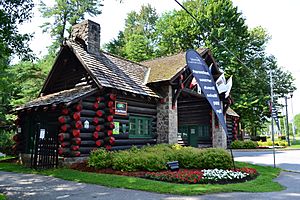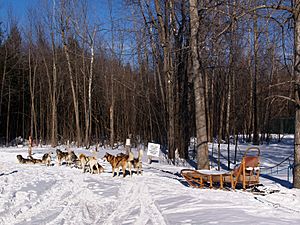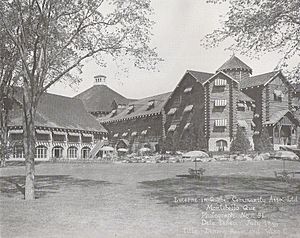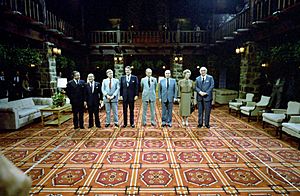Château Montebello facts for kids
| Fairmont Le Château Montebello | |
| Hotel facts and statistics | |
|---|---|
| Coordinates | 45°38′42″N 74°57′00″W / 45.645°N 74.95°W |
| Address | |
| Opening date | 1 July 1930 |
| Management | Fairmont Hotels and Resorts |
| Owner | Evergrande Group |
| No. of rooms | 211 |
| of which suites | 14 |
The Fairmont Le Château Montebello is a famous hotel and resort in Montebello, Quebec, Canada. It's known for its huge game reserve and is said to be the biggest wooden building in the world! Victor Nymark built this amazing wooden hotel.
It opened in 1930 and has 211 rooms and suites. It looks like a cozy, rustic lodge. The Canadian Pacific Railway first owned it. It's one of Canada's 'grand railway hotels'. For a long time, it was a private club called the Seigniory Club. In 1970, it became a public resort. Today, the Evergrande Group owns it, and Fairmont Hotels and Resorts manages it.
Contents
Where is Château Montebello?
The Château Montebello is at 392 rue Notre Dame in Montebello, Quebec. This town is in the Outaouais region. The road, Quebec Route 148, goes right through the property.
The hotel's main buildings are south of the road. North of the road, you'll find the golf course and trails. The resort is surrounded by a road, a river, and forests. The Ottawa River is to the south. This river is the border between Ontario and Quebec.
Other fun places are close by. Parc Omega, a safari park with local animals, is north of the resort. Plaisance National Park is about 16 km (10 mi) west. It's a provincial park for outdoor fun.
Fun Things to Do at the Resort
The Château Montebello is open all year. It's in old forests and near parts of the Canadian Shield. The land was once a gift from the French king in the 1600s.
The resort has many things to do:
- A marina with 114 spots for boats. It's open from mid-May to mid-October. Boats up to 18.3 meters (60 feet) long can dock here. Guests using the marina can enjoy all the resort's features.
- 60 km (37 mi) of hiking trails.
- 26 km (16 mi) of cross-country skiing trails.
- An 18-hole golf course designed by Stanley Thompson. It has a bar at the 18th hole.
- Two skating rinks for ice hockey and skating.
- A snow tubing hill.
- A curling rink.
- Two tennis courts.
You can also rent gear for dogsledding, snowshoeing, snowmobiling, biking, fishing, horseback riding, and kayaking.
Fairmont Kenauk Game Reserve
The resort has a huge game reserve called Fairmont Kenauk. It's about 263 square kilometers (65,000 acres). This preserve has over 70 lakes. It's home to a fish hatchery and more than 200 types of birds. Over 50 other animal species live here too. The resort has biologists and naturalists working to protect the area. You can stay in one of 13 cabins or chalets within the preserve. They have one to five bedrooms.
Manoir Papineau Museum
West of the main hotel is Manoir Papineau. This is a National Historic Site. It's a house with towers that is now a history museum. It looks different from the log cabin style of the resort.
The Amazing Hotel Building
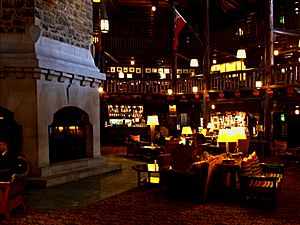
Building Design
The hotel building is a huge wooden structure. It's said to be the largest log building in the world! Victor Nymark, a master log builder from Finland, led the construction. He came to Canada in 1924. The builders sometimes worked without full plans.
The three main buildings, built in 1930, used 10,000 western red cedar logs. These logs came all the way from British Columbia. The outside walls are painted black. But inside, you can see the natural wood color. The roof has 500,000 hand-split cedar shakes. There are also 166 km (103 mi) of wooden moulding.
The hotel has 211 rooms and suites. Four wings spread out from the main lobby like a star. The log rafters above the lobby are almost 21.3 meters (70 feet) long. The round lobby is the heart of the hotel. It has a three-story open space built around a giant stone fireplace. The chimney goes up 20 meters (66 feet). A mezzanine and a third-floor balcony surround it.
Hotel Features
The hotel has several restaurants. Aux Chantignoles is the main dining room. You can also eat at Le Riverain or have a drink at The Seigneurie Bar. The hotel has 17 rooms for events like conferences or parties.
There are also many fun things to do inside. There's a fitness center. The hotel's 23-meter (75-foot) indoor swimming pool is in a separate log cabin. You can reach it by a tunnel from the hotel. The pool area has colorful totem poles holding up the roof. There are also two whirlpool baths and two saunas. The hotel also has a spa with eight treatment rooms.
History of Château Montebello
François de Laval, the first Bishop of Quebec, bought this land in 1674. Later, in 1801, the land was sold to the family of Joseph Papineau. His son, Louis-Joseph Papineau, built the stone mansion called Manoir Papineau.
In the late 1920s, Harold M. Saddlemire, a businessman from Switzerland and America, bought the land. He wanted to create a private retreat for important leaders. He first called it "Lucerne-in-Quebec." Later, it became the Seigniory Club. Even with the 1929 Wall Street Crash of 1929, building started in early 1930.
The project moved fast because important people were involved. These included the presidents of major banks and the Premier of Quebec. A special train track was built to bring logs and supplies. Victor Nymark and Harold Landry Furst managed the building. Teams worked day and night. An army of 3500 workers finished the project in just four months! The club opened on July 1, 1930. Three days later, a big costume ball was held. The Governor General of Canada attended.
The Seigniory Club was a very private place for its first 40 years. Only special members could join. Famous Canadian members included Lester B. Pearson, who became Prime Minister of Canada. Other important guests included Queen Juliana of the Netherlands, Prince Ranier and Princess Grace of Monaco. Also, Crown Prince Akihito of Japan, Bing Crosby, Perry Como, Bette Davis, Joan Crawford, and Harry S. Truman visited. President Harry S. Truman came in 1947 to fish for his first Canadian trout. Edward, Prince of Wales also visited.
The resort stayed private until 1970. Then, Canadian Pacific Hotels made it a public resort. They renamed it the Château Montebello.
In 1981, the Château Montebello hosted the 7th G7 summit. Leaders like Pierre Trudeau, Margaret Thatcher, Ronald Reagan, and François Mitterrand stayed there. In 1983, the Bilderberg Group held its yearly meeting at the resort. Later that year, NATO's Nuclear Planning Group also met there.
In 1995, the American National Trust for Historic Preservation gave a special award to Château Montebello. It was one of only two Canadian hotels to get this honor.
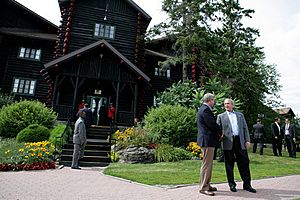
In 2001, Canadian Pacific Hotels changed its name to Fairmont Hotels and Resorts. The resort's name became Fairmont Le Château Montebello. Fairmont continued to manage the property, even after it was sold to the OMERS in 2006.
In 2007, the resort hosted the Security and Prosperity Partnership of North America conference. This was a meeting between the leaders of Canada, Mexico, and the United States. Stephen Harper, Felipe Calderón, and George W. Bush attended.
In 2014, the Evergrande Group, a Chinese company, bought the resort. They started a $15 million renovation project. Many rooms were updated by 2019.
See also
 In Spanish: Château Montebello para niños
In Spanish: Château Montebello para niños


